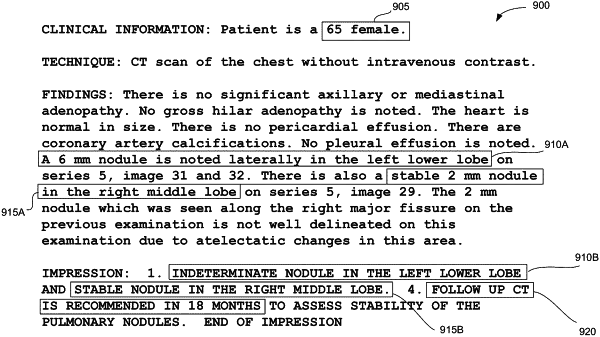| CPC G16H 50/20 (2018.01) [G06F 40/143 (2020.01); G06F 40/166 (2020.01); G06F 40/30 (2020.01); G10L 15/00 (2013.01); G16H 15/00 (2018.01)] | 17 Claims |

|
1. A system comprising:
at least one processor; and
at least one storage medium storing executable instructions that, when executed by the at least one processor, cause the at least one processor to carry out a method comprising:
evaluating a medical recommendation of a medical professional with respect to a patient encounter to determine whether the medical recommendation is consistent with at least one medical guideline, wherein evaluating the medical recommendation to determine whether the medical recommendation complies with the at least one medical guideline comprises:
extracting, using a natural language understanding engine and in real-time, one or more facts from at least one narrative provided by the medical professional in connection with the patient encounter, wherein at least one fact of the one or more extracted facts is a medical finding, and wherein the natural language understanding engine uses a machine learning technique selected from the group consisting of maximum entropy modeling, support vector machines, and random fields, wherein the machine learning technique is trained on a training corpus of hand-annotated medical documentation that was previously hand-annotated by a human labeler with expert knowledge of the domain to identify all extracted features and associated entity labels describing facts in the documentation, the training including learning, for each extracted feature in the training corpus, a probability with which tokens having that feature are associated with each entity type, and wherein the training corpus of hand-annotated medical documentation is utilized to train the machine learning technique to automatically label input tokens of the at least one narrative provided by the medical professional based on the learned probability;
selecting, based on at least the medical finding and from among a set of medical guidelines, the at least one medical guideline that is applicable to the patient encounter; and
determining, using the one or more facts extracted from the at least one narrative, whether the medical recommendation is consistent with the at least one medical guideline, wherein determining whether the medical recommendation complies with the at least one medical guideline comprises:
applying one or more decision rules associated with the at least one medical guideline to the one or more facts extracted from the at least one narrative, including the medical finding, the one or more decision rules comprising at least one recommendation called for by the at least one medical guideline;
determining whether the medical recommendation is consistent with the at least one recommendation called for by the at least one medical guideline; and
generating an audible alert when the medical recommendation is inconsistent with the at least one recommendation called for by the at least one medical guideline, wherein the alert indicates the at least one recommendation called for by the at least one medical guideline, and wherein the at least one recommendation called for by the at least one medical guideline is accepted or rejected by the medical professional.
|